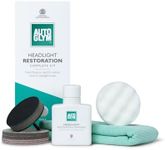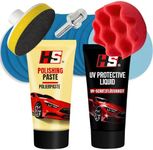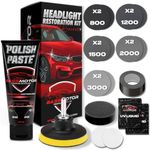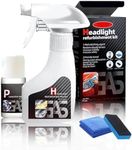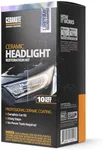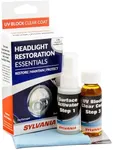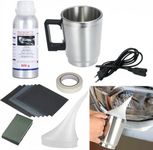Buying Guide for the Best Headlight Restoration Kits
When it comes to headlight restoration kits, the goal is to restore the clarity and brightness of your vehicle's headlights, which can become cloudy or yellowed over time due to exposure to the elements. A good restoration kit can improve visibility and safety while driving at night. Choosing the right kit involves understanding the components and effectiveness of the products available. It's important to consider the ease of use, the results you desire, and the time you are willing to invest in the restoration process.Type of KitHeadlight restoration kits generally come in two types: manual and power tool-assisted. Manual kits include sandpaper, polishing compounds, and a sealant, and they require elbow grease to restore the headlights. These are great for those who prefer a hands-on approach and have the time to dedicate to the process. Power tool-assisted kits, on the other hand, come with attachments for drills or other power tools, making the process faster and less labor-intensive. If you have access to a drill and prefer a quicker process, this might be the better option for you.
Abrasive MaterialsThe abrasive materials in a headlight restoration kit are used to remove the oxidized layer on the headlight lens. These materials can range from sandpaper of various grits to abrasive pads. The grit level is important: lower grit numbers (like 400) are more abrasive and used for heavy oxidation, while higher grit numbers (like 2000) are finer and used for polishing. If your headlights are severely oxidized, you might need a kit with a range of grits to gradually restore clarity. For minor cloudiness, a kit with higher grit sandpaper might suffice.
Polishing CompoundThe polishing compound is used after sanding to smooth out the surface of the headlight and enhance clarity. It is crucial because it helps to remove fine scratches left by the abrasive materials and brings out the shine. The effectiveness of the polishing compound can vary, so look for kits that include a high-quality compound. If you want a professional-looking finish, ensure the kit has a good polishing compound. For those who are less concerned with aesthetics and more with functionality, a basic compound may be adequate.
UV SealantA UV sealant is applied after polishing to protect the headlights from future UV damage and oxidation. This is important because it prolongs the clarity and effectiveness of the restoration. Kits with a UV sealant are generally more effective in maintaining the results over time. If you live in an area with high sun exposure, a kit with a strong UV sealant is essential to prevent the headlights from yellowing again quickly. For areas with less sun exposure, the sealant is still beneficial but might not need to be as robust.
Ease of UseEase of use refers to how straightforward the kit is to use, including the clarity of instructions and the number of steps involved. Some kits are designed for beginners and come with detailed instructions and fewer steps, making them easier to use. Others might be more complex and suited for those with experience in car maintenance. If you're new to headlight restoration, look for a kit that is marketed as easy to use or beginner-friendly. If you have some experience, you might opt for a more comprehensive kit that offers more control over the process.
Time RequiredThe time required to complete the restoration process can vary significantly between kits. Some kits promise results in as little as 30 minutes, while others may take a couple of hours. Consider how much time you are willing to invest in the process. If you have a busy schedule, a quicker kit might be more suitable. However, if you enjoy car maintenance and have the time, a more thorough kit that takes longer might provide better results.


